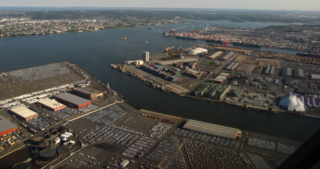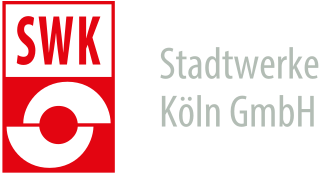
Mainz is the capital and largest city of Rhineland-Palatinate, Germany.

Duisburg is a city in the Ruhr metropolitan area of the western German state of North Rhine-Westphalia. Lying on the confluence of the Rhine and the Ruhr rivers in the center of the Rhine-Ruhr Region, Duisburg is the 5th largest city in North Rhine-Westphalia and the 15th-largest city in Germany.

Port Newark–Elizabeth Marine Terminal, a major component of the Port of New York and New Jersey, is the principal container ship facility for goods entering and leaving the New York metropolitan area and the northeastern quadrant of North America. Located on Newark Bay, the facility is run by the Port Authority of New York and New Jersey. Its two components, Port Newark and the Elizabeth Marine Terminal sit side by side within the cities of Newark and Elizabeth, New Jersey, just east of the New Jersey Turnpike and Newark Liberty International Airport.

The Port of Boston is a major seaport located in Boston Harbor and adjacent to the City of Boston. It is the largest port in Massachusetts and one of the principal ports on the East Coast of the United States.

The Port of Hamburg is a seaport on the river Elbe in Hamburg, Germany, 110 kilometres (68 mi) from its mouth on the North Sea.
The Port of Montreal is a cruise and transshipment point located on the St. Lawrence River in Montreal, Québec, Canada. The port operates as an international container port where it services Toronto and the rest of Central Canada, the Midwestern United States, and the Northeastern United States. Though found on the Saint Lawrence Seaway and some 1,600 kilometres (990 mi) inland from the Atlantic Ocean, it is the shortest direct route between Europe and the Mediterranean, with the North American Midwest.

The Rhine–Herne Canal is a 45.6-kilometre-long (28.3 mi) transportation canal in the Ruhr area of North Rhine-Westphalia, Germany, with five canal locks. The canal was built over a period of eight years and connects the harbour in Duisburg on the Rhine with the Dortmund-Ems Canal near Henrichenburg, following the valley of the Emscher. It was widened in the 1980s. The Rhein-Herne canal ship was designed specifically for this canal; normally of about 1300–1350 ton capacity, it has a maximum draft of 2.50 metres (8.2 ft), a length of approximately 80 metres (260 ft), and maximum beam of 9.50 metres (31.2 ft).

Mainz Hauptbahnhof is a railway station for the city of Mainz in the German state of Rhineland-Palatinate. It is used by about 60,000 travelers and visitors each day and is therefore by far the busiest station in Rhineland-Palatinate. The station was a trial area for a CCTV scheme using automated face recognition.

Mannheim Harbour, named Rhein-Neckar-Hafen Mannheim, is a river port on the Rhine in Mannheim, at the confluence of the Rhine and the Neckar in Baden-Wurttemberg. It consists out of 4 main harbour areas Handelshafen, Rheinauhafen, Altrheinhafen and Industriehafen, which are divided into 14 single harbour basins and 3 river docks.
The Port of Constanța is located in Constanța, Romania, on the western coast of the Black Sea, 179 nautical miles (332 km) from the Bosphorus Strait and 85 nmi (157 km) from the Sulina Branch, through which the Danube river flows into the sea. It covers 3,926 ha, of which 1,313 ha is land and the rest, 2,613 ha is water. The two breakwaters located northwards and southwards shelter the port, creating the safest conditions for port activities. The present length of the north breakwater is 8,344 m (5.185 mi) and the south breakwater is 5,560 m (3.45 mi). The Port of Constanța is the largest on the Black Sea and the 17th largest in Europe.
The staple right, also translated stacking right or storage right, both from the Dutch stapelrecht, was a medieval right accorded to certain ports, the staple ports. It required merchant barges or ships to unload their goods at the port and to display them for sale for a certain period, often three days. Only after that option had been given to local customers were traders allowed to reload their cargo and travel onwards with the remaining unsold freight.
Hamburger Hafen und Logistik AG, known until 2005 as Hamburger Hafen- und Lagerhaus-Aktiengesellschaft, and prior to that as Hamburger Freihafen-Lagerhaus Gesellschaft (HFLG) since 1885, is a German logistics and transportation company specialising in port throughput and container and transport logistics.

The Port of Tokyo is one of the largest Japanese seaports and one of the largest seaports in the Pacific Ocean basin having an annual traffic capacity of around 100 million tonnes of cargo and 4,500,000 twenty-foot equivalent units.
The Wanne-Herner Eisenbahn und Hafen GmbH is a railway and canal port operating company based around the Rhine-Herne Canal in the Ruhr area of Germany

Jens Beutel was a German judge and politician. A member of the Social Democratic Party (SPD), he served as Oberbürgermeister (mayor) of Mainz, the state capital of Rheinland-Pfalz, from 1997 to 2011. During his tenure, the city improved especially by building projects, including the new synagogue, and new parks.

A navis lusoria is a type of a small military vessel of the late Roman Empire that served as a troop transport. It was powered by about thirty soldier-oarsmen and an auxiliary sail. Nimble, graceful, and of shallow draft, such a vessel was used on northern rivers close to the Limes Germanicus, the Germanic border, and thus saw service on the Rhine and the Danube. The Roman historian Ammianus Marcellinus mentioned the navis lusoria in his writings, but not much about it could be learned until the discovery of such boats at Mainz, Germany in 1981–82.

Stadtwerke Köln GmbH is the infrastructure and services company of the City of Cologne.
JF Hillebrand is an international logistics company specializing in beer, wine and distilled spirits. The company provides airfreight, inland transport, warehousing, insurance, and inventory management. It's based in Mainz, Germany. Its US subsidiary is located in Napa Valley. Its services range from full container loads of bulk wine to small consignments via airfreight.

Thee Ingelheimer Aue is a previous Rhine island, located on the left bank of the river by the city of Mainz, between 500 and 503,5 km from the river mouth. It forms the northernmost point of the city division Mainz-Neustadt and is used for commercial purposes.

Frankfurt am Main has multiple inland ports which have been converted over time into new residential areas, owing to both their central location and the appeal of the view of the Main (river) from urban living spaces.




















